2 中国科学院大学, 北京 100049
2 University of Chinese Academy of Sciences, Beijing 100049
在过去十年间,西南地区经历几次严重干旱,包括2006年夏旱,2009/2010年秋冬春连旱和2011年夏旱,均造成了严重的经济损失和社会危害(Wang et al., 2015a)。众多学者对这些干旱事件的成因进行了分析(彭京备等,2007;李永华等,2009;杨素雨等,2011;张万诚等,2011;黄荣辉等,2012;孙冷等,2012;王遵娅等,2012;杨辉等,2012)。
除了对西南严重干旱个例的研究,也有对西南干旱或降水的变化特征、预测因子及机理的研究。在我国西南地区,冬季雨量最少,夏季最多(董谢琼和段旭,1998),因而过去对夏季的研究较多。春季赤道中东太平洋及印度洋海表温度偏高,有利于西南地区东部夏季降水偏多(马振锋和谭友邦,2004;鲍媛媛等,2007;李永华等,2012)。冬春季节的青藏高原热状况,包括地面气温(华明,2003)、植被(华维等,2008)、积雪(周浩等,2010),以及高原上空100 hPa高度场(李跃清,2003)对西南地区夏季降水有指示意义。夏季青藏高原东南部大气热源偏强(弱),有利于西南地区东部夏季降水偏多(少)(李永华等,2011)。
从降水变率的角度,冬季降水量的变率最大,夏季最小,春秋变率相差不大(董谢琼和段旭,1998)。因而,对冬季降水变化也有不少研究。这些研究发现西南地区冬季降水变化主要与北极涛动(琚建华等,2011;Yang et al., 2012)、北大西洋涛动(宋洁等,2011;徐寒列等,2012;Ruan et al., 2015)、北半球环状模异常(蒋兴文和李跃清,2010)有关,也与ENSO有关(Li and Zhou, 2015;Ruan et al., 2015)。还有一些研究从干、湿季节的角度分析降水变化机理(Feng et al., 2013;张武龙等,2014)。
事实上,西南地区秋季降水量占年降水量的比重也达到20%以上(Wu et al., 2003),仅次于夏季,高于春季和冬季(周秀华和肖子牛,2015)。而且近50年来,秋季干旱加重的趋势更明显(彭贵芬等,2009;李聪等,2012)。秋季连接夏季和冬季,是降水由多转少的过渡季节,连接本来就降水稀少的冬季,很容易产生秋冬季连旱,如2009/ 2010年西南大旱就是从2009年秋季开始的(沙天阳等,2013)。因此,加强对秋季降水的研究很有必要。
已有研究指出,西南地区东部秋季降水量年际变化与苏门答腊-西太平洋和热带东太平洋的海温分布存在很好的关系(沙天阳等,2013)。印度洋偶极子正位相对应中国西南地区秋季降水正异常(刘宣飞和袁慧珍,2006a),当印度洋偶极子与厄尔尼诺同时出现时,中国西南地区秋季降水正异常区域维持并向东扩展(刘宣飞和袁慧珍,2006b)。当发生暖池厄尔尼诺时,西北太平洋出现异常气旋式环流,西南秋季降水偏少(Zhang et al., 2011, 2013, 2014)。西南秋季降水的年际变化还与西北太平洋海温有显著负相关(Wang et al., 2015b)。由此可见,西南地区秋季降水变化与热带太平洋和印度洋的热状况有关,但是不同作者得到的海温关键区存在差异,这主要与选取的西南区域范围不同有关,也反映了西南地区气候的复杂性。
我国西南地区地理位置特殊,西北侧是青藏高原大地形,西南部为孟加拉湾,东临南海。既受高原热力和动力作用的直接影响,又有来自印度洋和太平洋的暖湿气流在此交汇。另外其本身范围内包含了盆地、丘陵等多种地形。这些因素共同导致了该地区复杂多样的气候特点。有研究指出,西南地区秋季干湿变化存在全区一致、东西相反和南北相反的特征(徐栋夫等,2014;Li et al., 2015)。干湿状况由降水和蒸发的相对大小决定,那么单从降水的年际变化的角度,西南地区是否具有空间一致性?如果不一致,不同区域的降水变化机理又有何不同?基于上述问题,本文先对西南地区的秋季降水按照其年际变化的规律进行分区,进而分析影响各区域降水变化的物理过程和机理。
2 资料和方法降水数据是中国气象局的全国台站逐日降水数据,将其处理成月平均资料,并从中选出了1980~2010年秋季无缺测的554个站点。为了便于计算绘图,从站点插值成0.5°×0.5°格点资料。大气环流资料为欧洲中期天气预报中心提供的ERA-Interim月平均再分析资料(Dee et al., 2011),水平分辨率为1.5°×1.5°。海温资料为英国哈德莱中心的月平均海表温度资料(Rayner et al., 2003),水平分辨率为1°×1°。另外,还用到美国国家海洋大气局气候预测中心(CPC/NOAA)提供的逐月斯堪的纳维亚遥相关指数(http://www.cpc.ncep.noaa.gov/data/teledoc/scand.shtml [2015-09-15])。
在分析西南秋季降水的空间差异时,采用聚类分析和旋转经验正交函数分解(REOF)方法。聚类分析是研究样本分类问题的一种多元统计方法(施能,2009)。这里采用其中常用的系统聚类法(即逐步归并),并以同一类中所有样本与另一类所有样本之间的相关系数的平均值作为衡量两类相似性水平的标准(即均值联结法)。已有研究表明这是一种有效的分区方法(如:秦爱民和钱维宏,2006;刘扬等,2012;韩微和翟盘茂,2015)。REOF也是一种常用的分区方法(闵屾和钱永甫,2008;韦道明和李崇银,2009;陈豫英等,2011;熊敏诠,2015),这里用来验证聚类分析的结果。使用功率谱方法分析降水变化的周期。运用相关、一元线性回归方法分析与降水变化相关的环流和海温场。20世纪70年代中后期全球气候经历了一次显著的年代际突变(Trenberth, 1990;Wallace et al., 1993),为了避免年代际变化的影响,本文的研究时段为1970年代之后的1980~2010年的秋季(9~11月)。西南秋季降水近几十年存在显著的减少趋势(Wang et al., 2015a),本文关注的是年际时间尺度的变化,因此对所有变量均先去除了线性趋势。
3 西南降水年际变化空间特征对全国1980~2010年的站点秋季降水进行聚类分析,得到谱系图(图略),以区域之间的相似性水平不超过0.3(90%信度)为界限,得到分区图(图 1),相同颜色的站点表示其年际变化存在一致性,被分为一区。其中,我国长江以南的地区主要分为四个区:500米等高线以东的平原地区,以东西走向的南岭为界,分为南、北两个区域,称为江南区(红色站点)和华南区(紫色站点);500~3000米等高线之间的区域,即我国西南地区,大致以南北走向的1500米等高线为界,分为东、西两个区域,称为西南东部(蓝色站点)和西南西部(绿色站点)。该分区结果与地形高度有较好的对应关系,其物理联系还需进一步研究。
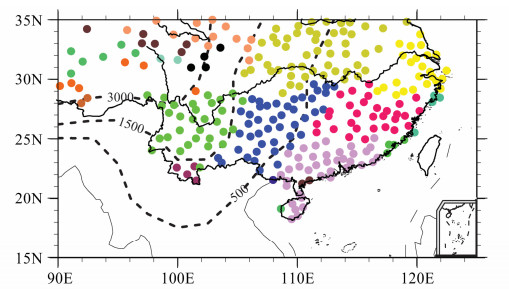
|
图 1 1980~2010年我国站点秋季降水聚类分析结果,相同颜色表示分为一区。虚线分别为500 m、1500 m、3000 m等高线 Figure 1 Results of cluster analysis for autumn rainfall collected from weather stations during 1980-2010. Stations clustered into the same subregion are shown by the same color. The dashed lines are isohypses for 500 m, 1500 m, and 3000 m |
为了验证上述分区结果,对我国南方(20°~30°N)秋季降水做旋转经验正交函数分解(REOF),结果如图 2。REOF的前四个分量的大值中心与聚类分析法得到的四个区域一致。REOF1为江南区,REOF2为华南区,REOF3为西南西部区,REOF4为西南东部区。各旋转分量对应的时间系数,如图 2b(黑色线),与聚类分析法得到的相应各区的区域平均降水序列(红色线),存在很高的相关,相关系数绝对值均超过0.9。两种不同的分区方法得到了一致的结果,表明此分区结果合理。本文关注的西南地区被分为了东、西两部分,其中西南东部是长江以南500~1500米等高线之间的区域,西南西部为长江以南1500~3000米等高线之间的区域。
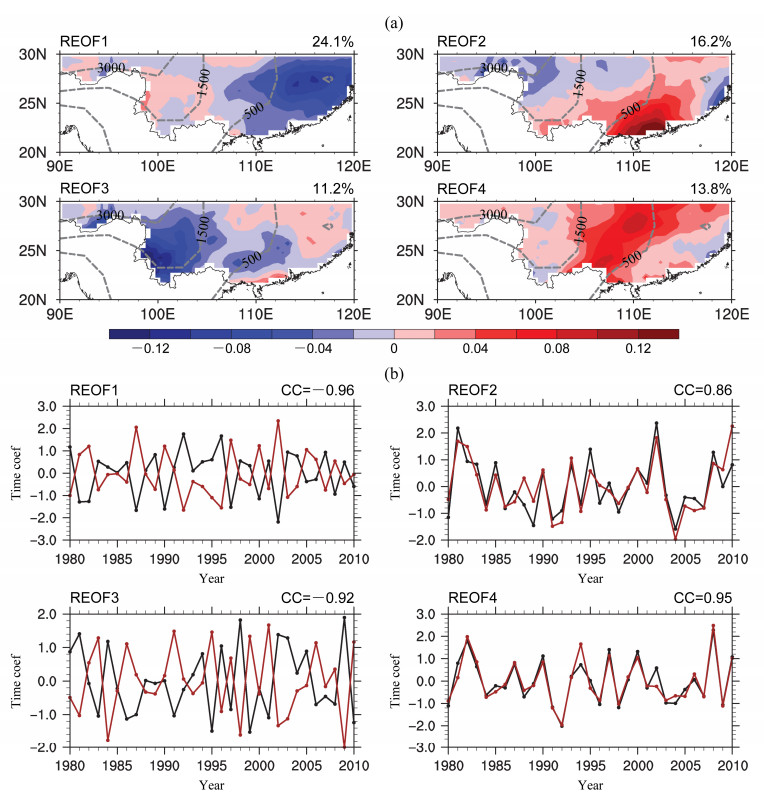
|
图 2 (a)1980~2010年我国南方(20°~30°N)地区秋季降水REOF分析的前四个模态,虚线分别为500 m、1500 m、3000 m等高线;(b)黑色线为REOF1-4模态对应的时间系数标准化序列,红色线为聚类分析得到的对应区域(即江南区、华南区、西南西部区、西南东部区)的平均降水标准化序列,CC为两者的相关系数 Figure 2 (a) The first four REOF (Rotated Empirical Orthogonal Function) modes of autumn rainfall in southern China (20°-30°N) during 1980-2010, the dashed lines are isohypses for 500 m, 1500 m and 3000 m; (b) normalized time series corresponding to the first four REOF modes (black lines). The red lines show the normalized time series of rainfall averaged over the corresponding cluster areas shown in Fig. 1. The "CC" indicates correlation coefficient between these two series |
对西南地区东、西部区域平均的降水序列做功率谱分析(图 3a、b),可见二者的显著周期有明显差异。西南地区东部降水的显著周期是3.6年和6.4年(图 3a),西部降水的显著周期是4~5年(图 3b)。西南地区东、西部降水逐年的旱涝异常情况也差别较大(图 3c)。以降水超过1倍标准差的年份作为旱涝异常年份,除了个别年份(1998年旱、2009年旱、2010年涝)东、西部旱涝一致,大部分的东部与西部旱涝异常年份不一致,在1991年还出现了西涝东旱的情况。除了降水本身年际变化的不同,与东、西部降水变化相联系的环流场也有明显差异。图 4给出了与西南东部、西部秋季降水序列与同期各层位势高度场的相关系数分布,可以看出:与东部降水变化显著相关的环流异常位于热带(图 4a-c),而对应于西部降水变化的环流异常则主要位于中高纬地区(图 4d-f)。因此,分析西南地区秋季降水变化机理,有必要分东、西部两个区域分别讨论。
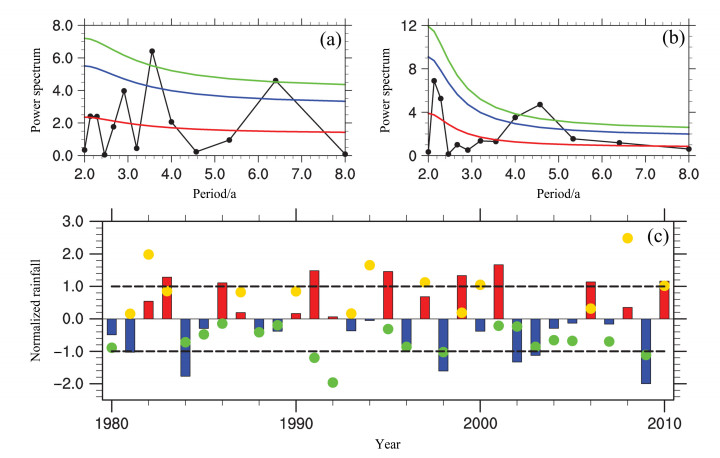
|
图 3 西南地区(a)东部和(b)西部降水序列的功率谱(黑色线),红色线表示马尔可夫红噪声谱,蓝色和绿色线分别表示90%、95%置信度。(c)西南地区东部(散点)、西部(柱状)标准化降水序列,虚线为1倍标准差 Figure 3 Power spectrum (black lines) of the (a) eastern and (b) western SWC (Southwest China) rainfall series. The red lines denote Markov red noise spectrum. The blue and green lines denote the 90% and 95% confidence levels respectively. (c) Normalized time series of rainfall in the eastern (dots) and western (bars) SWC. The dashed lines denote one standard deviation |
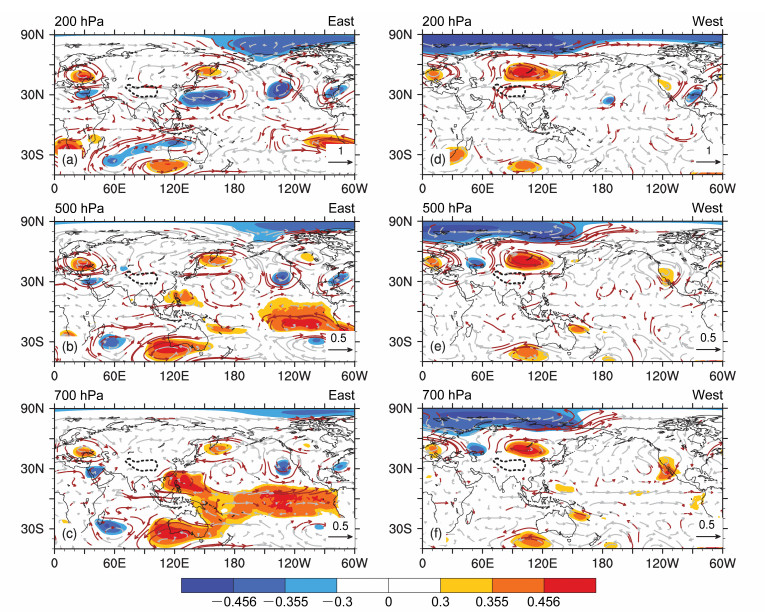
|
图 4 西南地区(a-c)东部、(d-f)西部秋季降水序列与同期(a, d)200 hPa、(b, e)500 hPa、(c, f)700 hPa位势高度场的相关系数分布(阴影,相关系数±0.3、±0.355、±0.456分别为90%、95%、99%信度)和标准化降水序列回归的风场(矢量,单位:m s−1,红色表示通过95%信度检验)。虚线为3000 m等高线 Figure 4 Spatial patterns of correlation coefficient between the (a-c) eastern and (d-f) western SWC autumn rainfall and simultaneous geopotential height at (a, d) 200 hPa, (b, e) 500 hPa, and (c, f) 700 hPa (shaded areas of±0.3, ±0.355, ±0.456 corresponds to 90%, 95%, 99% confidence levels, respectively). The vectors are the regression of wind versus rainfall (vectors, units: m s−1; red vectors indicate significance at 95% confidence level). The dashed line is 3000 m isohypse |
与西南东部秋季降水序列相关的同期环流场分布如图 4a-c,可以看到,当降水偏多时,700 hPa南海-菲律宾地区为显著的位势高度正异常,对应反气旋环流。西南东部位于该反气旋环流的西北侧,受西南气流影响,有利于降水偏多。该反气旋环流在500 hPa减弱,到200 hPa变成位势高度负异常对应气旋式环流,垂直方向上具有斜压性,应与低层的热力强迫有关。
图 5a是与西南东部秋季降水相关的同期海温场。当赤道东太平洋为暖海温异常、热带印度洋为西正东负的偶极子型海温异常时,西南东部降水偏多。从降水序列回归的低层风场(图 5a)和水汽输送场(图 5b)上可以看出,赤道东太平洋的暖海温异常,会在西北太平洋激发出反气旋环流(Zhang et al., 1996, 1999, 2002;Wang et al., 2000;Wang and Zhang, 2002),反气旋北侧的西南气流位于西南东部上空,为该地区输送水汽,有利于降水偏多;反之亦然。这与沙天阳等(2013)研究结果一致。同时,热带印度洋地区存在显著的西正东负的偶极子型海温异常,这种纬向海温梯度激发出赤道地区显著的东风异常,使孟加拉湾地区出现负涡度异常,对应反气旋式环流,该反气旋环流北侧的偏西气流越过中南半岛北部后,转为西南气流,为西南地区输送水汽,造成该地区降水偏多。这与之前研究发现的秋季印度洋偶极子正位相与中国南方秋季降水有显著正相关(刘宣飞和袁慧珍,2006a;Qiu et al., 2014)一致。综上所述,由赤道东太平洋海温正异常造成的来自西太平洋的水汽输送,和由热带印度洋海温偶极子型异常造成的来自孟加拉湾的水汽输送,在西南东部辐合(图 5b),造成该地区降水偏多。秋季各月的情况与季节平均的结果一致。
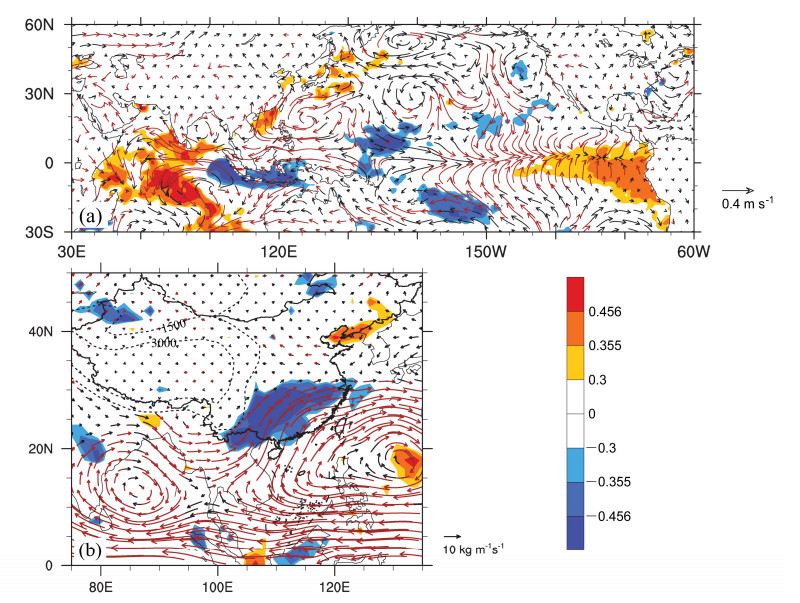
|
图 5 秋季西南地区东部(a)降水序列与海温场的相关系数分布(阴影)和降水序列回归的10 m风场(矢量,单位:m s−1),(b)降水序列与整层积分水汽通量散度场的相关系数分布(阴影)和降水序列回归的整层积分水汽通量场(矢量,单位:kg m−1s−1)。阴影,相关系数±0.3、±0.355、±0.456分别为90%、95%、99%信度。红色矢量表示通过95%信度检验。虚线分别为1500 m、3000 m等高线 Figure 5 (a) The spatial pattern of correlation coefficient between autumn rainfall and sea surface temperature in the eastern SWC (shaded areas) and regression of 10m wind (vectors, m s−1) vs. rainfall; (b) the spatial pattern of correlation coefficient between autumn rainfall and divergence of vertically integrated water vapor flux (shaded areas) and regression of vertically integrated water vapor flux (vectors, kg m−1 s−1) vs. the eastern SWC rainfall series.±0.3, ±0.355, ±0.456 are 90%, 95%, 99% confidence levels, respectively. The red vectors indicate significance at 95% confidence level. The dashed lines in (b) are 1500 m and 3000 m isohypses |
与西南西部秋季降水序列相关的同期环流场(图 4d−f)可见,季节平均上显著的信号在中高纬地区,且在200~700 hPa上都存在,为准正压结构。当北极区的位势高度为负异常、青藏高原以北到贝加尔湖地区的位势高度为正异常时,对应西南西部地区降水偏多。这样的环流异常如何影响西南地区的降水呢?事实上,西南西部的秋季降水较复杂:秋季三个月份的降水异常也与不同的环流形势对应(图 6)。
9月,西南西部降水主要受热带环流异常的影响(图 6a)。当对流层中低层中南半岛地区有反气旋环流异常,其西北侧的西南气流为西南西部输送暖湿空气,造成那里降水偏多。与图 4c中影响西南东部降水的西北太平洋反气旋相比,图 6a中的热带反气旋中心位置偏西,位于中南半岛,因此反气旋影响的区域也偏西,即西南西部。从图 6a中也看到贝加尔湖附近有位势高度正异常,与季节平均的情况一致(图 4f),但并不直接影响西南降水。与10月西南西部降水相关的环流场如图 6b。影响西南西部的是位于孟加拉湾的气旋式环流和高原以东-南海的反气旋式环流。孟加拉湾低槽前的西南气流,与南海-中南半岛北部的东南气流,共同为西南西部输送水汽,加强了气候态的两支水汽通道(罗霄等,2013),造成西南西部降水偏多。11月西南西部的降水序列与同期环流场的相关如图 6c。对应降水偏多:一方面,在贝加尔湖地区有显著的反气旋环流异常,其东南方的日本岛上空为显著的气旋式环流异常,二者之间的北风异常控制了中国东部,影响西南地区;另一方面,印度半岛至孟加拉湾地区有显著的位势高度负异常,使印缅槽加深,向西南地区的暖湿气流增强。于是,北方冷空气与孟加拉湾暖湿气流在西南西部交汇,造成那里降水偏多。秋冬季节冷空气的活动常与中高纬大气波动有关。
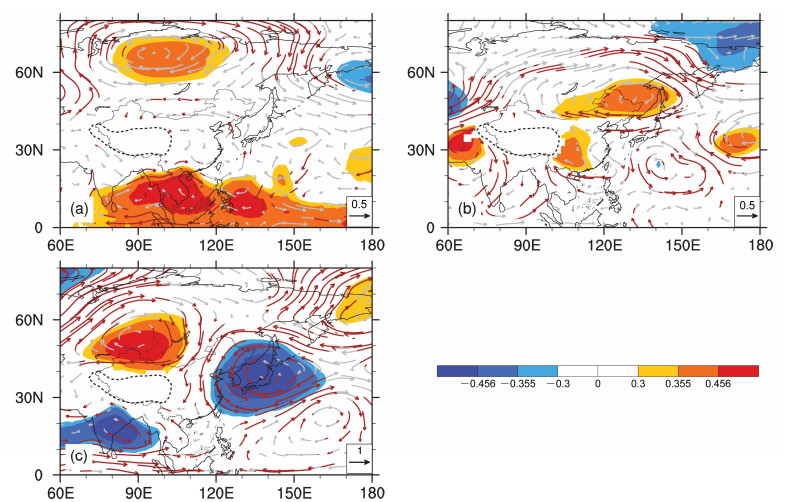
|
图 6 西南地区西部(a)9月、(b)10月、(c)11月降水序列与同期700 hPa位势高度场的相关系数分布(阴影,相关系数±0.3、±0.355、±0.456分别为90%、95%、99%信度)和降水序列回归的风场(矢量,单位:m s−1,红色表示通过95%信度检验)。虚线为3000 m等高线 Figure 6 Spatial patterns of correlation coefficient between rainfall series in the western SWC and simultaneous 700 hPa geopotential height for (a) September, (b) October, and (c) November. Shaded areas of±0.3, ±0.355, ±0.456 correspond to 90%, 95%, 99% confidence levels, respectively. The vectors are the regression of wind vs. rainfall (m s−1, red vectors indicate significance at 95% confidence level). The dashed line is 3000 m isohypse |
由11月降水变化与整个北半球700 hPa环流场的相关(图 7a)可见,降水偏多对应着斯堪的纳维亚遥相关型(SCAND)的负位相,在500 hPa、200 hPa上也有一致的环流型,是相当正压结构(图略)。SCAND由Barnston and Livezey (1987)首次提出,是欧亚大陆地区一个重要的大气遥相关型。Bueh and Nakamura (2007)分析了SCAND型在不同月份的特征,指出SCAND型在夏季较弱,在秋季和冬季比较明显。许多研究也指出SCAND型会对我国的气候产生影响(如:布和朝鲁等,2008;杨莲梅等,2010;刘毓赟和陈文,2012)。11月SCAND指数与同期西南西部降水序列的相关系数为−0.55,通过99%的信度检验。由负的SCAND指数与降水场的相关分布(图 7b)可见,当SCAND为负位相时,我国西南西部有显著的正降水异常,说明11月份西南西部降水可能受北半球SCAND遥相关影响。使用全球降水资料(图略)可以看到,SCAND指数负位相造成的降水偏多并不局限于西南西部,还包括缅甸地区和孟加拉湾东北部。
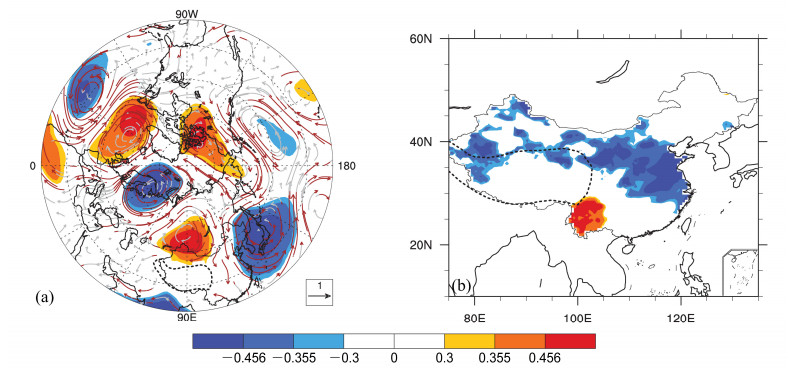
|
图 7 (a)西南地区西部11月降水序列与同期北半球700 hPa位势高度场的相关系数分布(阴影,相关系数±0.3、±0.355、±0.456分别为90%、95%、99%信度)和降水序列回归的风场(矢量,单位:m s−1,红色表示通过95%信度检验);(b)11月负的斯堪的纳维亚遥相关指数与同期降水场的相关系数分布。虚线为3000 m等高线 Figure 7 (a) The spatial pattern of correlation coefficient between the western SWC rainfall series and Northern Hemisphere 700 hPa geopotential height in November (shaded areas of±0.3, ±0.355, ±0.456 corresponds to 90%, 95%, 99% confidence levels, respectively) and the regression of 700 hPa wind with respect to the western SWC rainfall series (vectors, units: m s−1, red vectors indicate significance at 95% confidence level); (b) the spatial distribution of correlation coefficient between the negative SCAND (Scandinavian teleconnection pattern) index and rainfall in November. The dashed line is 3000 m isohypse |
对我国秋季降水的年际变化进行聚类分析和REOF分析,西南地区被分为东、西两个区域,分界线与1500米等高线的位置一致。西南东部和西南西部降水年际变化的显著周期、旱涝异常年份、相关的环流系统都有明显差异,因而需区别对待。
西南东部降水主要与热带海温异常有关,受低纬度环流影响。当赤道东太平洋为暖海温异常,热带印度洋为西正东负的偶极子型海温异常时,会分别激发出西北太平洋反气旋和孟加拉反气旋,共同向西南东部输送水汽,造成该地区降水偏多。
西南西部降水则较复杂,秋季三个月份的降水分别与不同的环流形势对应,中高纬系统的影响随季节的推进而增强。9月西南西部降水主要受热带系统影响,由中南半岛反气旋输送的暖湿气流决定。10月是过渡季节,受高原以东反气旋环流和孟加拉湾低槽共同影响。11月,中高纬系统成为影响西南西部降水的控制系统,西南西部降水与北半球SCAND遥相关存在显著的负相关,当SCAND为负(正)位相时,西南西部降水偏多(少)。
已有研究表明,云南和四川南部(即本文的西南西部地区)为西南干旱的频发和强度中心地区,而西南东部和北部干旱程度相对较轻(李韵婕等,2014)。过去对西南东部的研究已有不少,本文分析了与西南西部地区降水年际变化相关的主要环流异常,而引起环流异常的机理研究还需进一步加强,这对近年来旱灾频发的西南地区提高气候预测水平和防灾抗灾能力具有重要意义。
| [] | 鲍媛媛, 康志明, 金荣花, 等. 2007. 川渝地区夏季旱涝与海温异常浅析[J]. 气象, 33(5) : 89–93. Bao Yuanyuan, Kang Zhiming, Jin Ronghua, et al. 2007. Analysis of floods and droughts in Chongqing and East Sichuan[J]. Meteor.Mon., 33(5) : 89–93 DOI:10.3969/j.issn.1000-0526.2007.05.013 |
| [] | Barnston A G, Livezey R E. 1987. Classification, seasonality and persistence of low-frequency atmospheric circulation patterns[J]. Mon.Wea.Rev., 115(6) : 1083–1126 DOI:10.1175/1520-0493(1987)115<1083:CSAPOL>2.0.CO;2 |
| [] | 布和朝鲁, 施宁, 纪立人. 2008. 2000/2001年冬季北欧异常流型形成机理及其对我国北方天气的影响[J]. 高原气象, 27(1) : 76–83. Bueh Cholaw, Shi Ning, Ji Liren. 2008. Maintenance mechanism of the Scandinavian pattern in its positive phase during 2000/2001 winter and its influence on the weather over the northern part of China[J]. Plateau Meteorology, 27(1) : 76–83 |
| [] | Bueh C, Nakamura H. 2007. Scandinavian pattern and its climatic impact[J]. Quart.J.Roy.Meteor.Soc., 133(629) : 2117–2131 DOI:10.1002/qj.173 |
| [] | 陈豫英, 陈楠, 钱正安, 等. 2011. 中蒙干旱半干旱区降水的时空变化特征(Ⅱ):综合气候分区及各分区降水周期变化的进一步分析[J]. 高原气象, 30(1) : 13–21. Chen Yuying, Chen Nan, Qian Zheng'an, et al. 2011. Temporal and spatial change features of precipitation over CMASA (Ⅱ):Synthetical climate subregions of the CMASA and further analyses of periodic change of precipitation in its various ones[J]. Plateau Meteorology, 30(1) : 13–21 |
| [] | Dee D P, Uppala S M, Simmons A J, et al. 2011. The ERA-Interim reanalysis:Configuration and performance of the data assimilation system[J]. Quart.J.Roy.Meteor.Soc., 137(656) : 553–597 DOI:10.1002/qj.828 |
| [] | 董谢琼, 段旭. 1998. 西南地区降水量的气候特征及变化趋势[J]. 气象科学, 18(3) : 239–247. Dong Xieqiong, Duan Xu. 1998. Climatic characteristics and variation tendency of precipitation in the southwest region of China[J]. Scientia Meteor.Sinica, 18(3) : 239–247 |
| [] | Feng L, Li T, Yu W D. 2013. Cause of severe droughts in Southwest China during 1951-2010[J]. Climate Dyn., 43(7-8) : 2033–2042 DOI:10.1007/s00382-013-2026-z |
| [] | 韩微, 翟盘茂. 2015. 三种聚类分析方法在中国温度区划分中的应用研究[J]. 气候与环境研究, 20(1) : 111–118. Han Wei, Zhai Panmao. 2015. Three cluster methods in regionalization of temperature zones in China[J]. Climatic Environ.Res., 20(1) : 111–118 DOI:10.3878/j.issn.1006-9585.2014.13210 |
| [] | 华明. 2003. 青藏高原热状况对夏季西南地区气候影响的分析及模拟[J]. 高原气象, 22(S) : 152–156. Hua Ming. 2003. Analysis and simulation study on the influence of heat condition over Qinghai-Xizang Plateau on climate over South-West China[J]. Plateau Meteorology, 22(S) : 152–156 DOI:10.3321/j.issn:1000-0534.2003.z1.020 |
| [] | 华维, 范广洲, 周定文, 等. 2008. 青藏高原冬、春季植被特征及其对西南地区夏季降水的影响[J]. 气象科学, 28(4) : 363–369. Hua Wei, Fan Guangzhou, Zhou Dingwen, et al. 2008. Characteristics of winter and spring vegetation variation over Tibetan Plateau and its influence on summer precipitation of Southwest China[J]. Scientia Meteor.Sinica, 28(4) : 363–369 DOI:10.3969/j.issn.1009-0827.2008.04.002 |
| [] | 黄荣辉, 刘永, 王林, 等. 2012. 2009年秋至2010年春我国西南地区严重干旱的成因分析[J]. 大气科学, 36(3) : 443–457. Huang Ronghui, Liu Yong, Wang Lin, et al. 2012. Analyses of the causes of severe drought occurring in Southwest China from the fall of 2009 to the spring of 2010[J]. Chinese J.Atmos.Sci., 36(3) : 443–457 DOI:10.3878/j.issn.1006-9895.2011.11101 |
| [] | 蒋兴文, 李跃清. 2010. 西南地区冬季气候异常的时空变化特征及其影响因子[J]. 地理学报, 65(11) : 1325–1335. Jiang Xingwen, Li Yueqing. 2010. The spatio-temporal variation of winter climate anomalies in southwestern China and the possible influencing factors[J]. Acta Geographica Sinica, 65(11) : 1325–1335 DOI:10.11821/xb201011002 |
| [] | 琚建华, 吕俊梅, 谢国清, 等. 2011. MJO和AO持续异常对云南干旱的影响研究[J]. 干旱气象, 29(4) : 401–406. Ju Jianhua, LüJunmei, Xie Guoqing, et al. 2011. Studies on the influences of persistent anomalies of MJO and AO on drought appeared in Yunnan[J]. J.Arid Meteor., 29(4) : 401–406 DOI:10.3969/j.issn.1006-7639.2011.04.001 |
| [] | Li Dongliang, Xu Dongfu, Wang Hui, et al. 2015. Characterization and causal analysis of temporal and spatial variation in dry-wet conditions in autumn in Southwest China[J]. J.Trop.Meteor., 21(1) : 55–66 |
| [] | Li Xiuzhen, Zhou Wen. 2015. Modulation of the interannual variation of the India-Burma Trough on the winter moisture supply over Southwest China[J]. Climate Dyn DOI:10.1007/s00382-015-2575-4 |
| [] | 李聪, 肖子牛, 张晓玲. 2012. 近60年中国不同区域降水的气候变化特征[J]. 气象, 38(4) : 419–424. Li Cong, Xiao Ziniu, Zhang Xiaoling. 2012. Climatic characteristics of precipitation in various regions of China for the past 60 years[J]. Meteor.Mon., 38(4) : 419–424 DOI:10.7519/j.issn.1000-0526.2012.4.005 |
| [] | 李永华, 徐海明, 刘德. 2009. 2006年夏季西南地区东部特大干旱及其大气环流异常[J]. 气象学报, 67(1) : 122–132. Li Yonghua, Xu Haiming, Liu De. 2009. Features of the extremely severe drought in the East of Southwest China and anomalies of atmospheric circulation in summer 2006[J]. Acta Meteor.Sinica, 67(1) : 122–132 DOI:10.3321/j.issn:0577-6619.2009.01.013 |
| [] | 李永华, 卢楚翰, 徐海明, 等. 2011. 夏季青藏高原大气热源与西南地区东部旱涝的关系[J]. 大气科学, 35(3) : 422–434. Li Yonghua, Lu Chuhan, Xu Haiming, et al. 2011. Contemporaneous relationships between summer atmospheric heat source over the Tibetan Plateau and drought/flood in eastern Southwest China[J]. Chinese J.Atmos.Sci., 35(3) : 422–434 DOI:10.3878/j.issn.1006-9895.2011.03.04 |
| [] | 李永华, 卢楚翰, 徐海明, 等. 2012. 热带太平洋-印度洋海表温度变化及其对西南地区东部夏季旱涝的影响[J]. 热带气象学报, 28(2) : 145–156. Li Yonghua, Lu Chuhan, Xu Haiming, et al. 2012. Anomalies of sea surface temperature in Pacific-Indian Ocean and effects on drought/flood in summer over eastern of Southwest China[J]. J.Trop.Meteor., 28(2) : 145–156 DOI:10.3969/j.issn.1004-4965.2012.02.001 |
| [] | 李跃清. 2003. 青藏高原地面加热及上空环流场与东侧旱涝预测的关系[J]. 大气科学, 27(1) : 107–114. Li Yueqing. 2003. Surface heating in the Tibetan Plateau and general circulation over it and their relations with the prediction of drought-flood at its eastern side[J]. Chinese J.Atmos.Sci., 27(1) : 107–114 DOI:10.3878/j.issn.1006-9895.2003.01.10 |
| [] | 李韵婕, 任福民, 李忆平, 等. 2014. 1960~2010年中国西南地区区域性气象干旱事件的特征分析[J]. 气象学报, 72(2) : 266–276. Li Yunjie, Ren Fumin, Li Yiping, et al. 2014. A study of the characteristics of the southwestern China regional meteorological drought events during 1960-2010[J]. Acta Meteor.Sinica, 72(2) : 266–276 DOI:10.11676/qxxb2014.026 |
| [] | 刘宣飞, 袁慧珍. 2006a. 印度洋偶极子与中国秋季降水的关系[J]. 南京气象学院学报, 29(5) : 644–649. Liu Xuanfei, Yuan Huizhen. 2006a. Relationship between the Indian Ocean dipole and autumn rainfall in China[J]. J.Nanjing Inst.Meteor., 29(5) : 644–649 DOI:10.3969/j.issn.1674-7097.2006.05.009 |
| [] | 刘宣飞, 袁慧珍. 2006b. ENSO对印度洋偶极子与中国秋季降水关系的影响[J]. 南京气象学院学报, 29(6) : 762–768. Liu Xuanfei, Yuan Huizhen. 2006b. Effects of ENSO on the relationship between IOD and autumn rainfall in China[J]. J.Nanjing Inst.Meteor., 29(6) : 762–768 DOI:10.3969/j.issn.1674-7097.2006.06.006 |
| [] | 刘扬, 韦志刚, 李振朝, 等. 2012. 中国北方地区降水变化的分区研究[J]. 高原气象, 31(3) : 638–645. Liu Yang, Wei Zhigang, Li Zhenchao, et al. 2012. Study on division of precipitation in northern China[J]. Plateau Meteorology, 31(3) : 638–645 |
| [] | 刘毓赟, 陈文. 2012. 北半球冬季欧亚遥相关型的变化特征及其对我国气候的影响[J]. 大气科学, 36(2) : 423–432. Liu Yuyun, Chen Wen. 2012. Variability of the Eurasian teleconnection pattern in the Northern Hemisphere winter and its influences on the climate in China[J]. Chinese J.Atmos.Sci., 36(2) : 423–432 DOI:10.3878/j.issn.1006-9895.2011.11066 |
| [] | 罗霄, 李栋梁, 王慧. 2013. 华西秋雨演变的新特征及其对大气环流的响应[J]. 高原气象, 32(4) : 1019–1031. Luo Xiao, Li Dongliang, Wang Hui. 2013. New evolution features of autumn rainfall in West China and its responses to atmospheric circulation[J]. Plateau Meteorology, 32(4) : 1019–1031 DOI:10.7522/j.issn.1000-0534.2013.00018 |
| [] | 马振锋, 谭友邦. 2004. 预测川渝地区汛期降水量的一种物理统计模型[J]. 大气科学, 28(1) : 138–145. Ma Zhenfeng, Tan Youbang. 2004. A physical statistic model for predicting the rainfall during flood season in Sichuan-Chongqing region[J]. Chinese J.Atmos.Sci., 28(1) : 138–145 DOI:10.3878/j.issn.1006-9895.2004.01.13 |
| [] | 闵屾, 钱永甫. 2008. 江淮梅雨分区特征的比较研究[J]. 应用气象学报, 19(1) : 19–27. Min Shen, Qian Yongfu. 2008. Comparative investigation on Meiyu parameters in different subregions of the Changjiang-Huaihe valley[J]. J.Appl.Meteor.Sci., 19(1) : 19–27 DOI:10.3969/j.issn.1001-7313.2008.01.003 |
| [] | 彭贵芬, 刘瑜, 张一平. 2009. 云南干旱的气候特征及变化趋势研究[J]. 灾害学, 24(4) : 40–44. Peng Guifen, Liu Yu, Zhang Yiping. 2009. Research on characteristics of drought and climatic trend in Yunnan Province[J]. J.Catastrophol., 24(4) : 40–44 |
| [] | 彭京备, 张庆云, 布和朝鲁. 2007. 2006年川渝地区高温干旱特征及其成因分析[J]. 气候与环境研究, 12(3) : 464–474. Peng Jingbei, Zhang Qingyun, Bueh Cholaw. 2007. On the characteristics and possible causes of a severe drought and heat wave in the Sichuan-Chongqing region in 2006[J]. Climatic Environ.Res., 12(3) : 464–474 DOI:10.3969/j.issn.1006-9585.2007.03.026 |
| [] | 秦爱民, 钱维宏. 2006. 近41年中国不同季节降水气候分区及趋势[J]. 高原气象, 25(3) : 495–502. Qin Aimin, Qian Weihong. 2006. The seasonal climate division and precipitation trends of China in recent 41 years[J]. Plateau Meteorology, 25(3) : 495–502 DOI:10.3321/j.issn:1000-0534.2006.03.017 |
| [] | Qiu Y, Cai W J, Guo X G, et al. 2014. The asymmetric influence of the positive and negative IOD events on China's rainfall[J]. Sci.Rep., 4 : 4943 DOI:10.1038/srep04943 |
| [] | Rayner N A, Parker D E, Horton E B, et al. 2003. Global analyses of sea surface temperature, sea ice, and night marine air temperature since the late nineteenth century[J]. J.Geophys.Res., 108(14) : 4407–4443 DOI:10.1029/2002JD002670 |
| [] | Ruan C Q, Li J P, Feng J. 2015. Statistical downscaling model for late-winter rainfall over Southwest China[J]. Science China Earth Sciences, 58(10) : 1827–1839 DOI:10.1007/s11430-015-5104-8 |
| [] | 沙天阳, 徐海明, 邹松佐. 2013. 中国西南地区东部秋季干旱的环流特征及其成因分析[J]. 大气科学学报, 36(5) : 593–603. Sha Tianyang, Xu Haiming, Zou Songzuo. 2013. Atmospheric circulation characteristics and cause analysis for autumn drought in the eastern region of Southwest China[J]. Trans.Atmos.Sci., 36(5) : 593–603 DOI:10.3969/j.issn.1674-7097.2013.05.010 |
| [] | 施能.2009. 气象统计预报[M]. 北京: 气象出版社 : 174 -183. Shi Neng.2009. Statistical Forecast of Meteorology[M]. Beijing: China Meteorological Press : 174 -183. |
| [] | 宋洁, 杨辉, 李崇银. 2011. 2009/2010年冬季云南严重干旱原因的进一步分析[J]. 大气科学, 35(6) : 1009–1019. Song Jie, Yang Hui, Li Chongyin. 2011. A further study of causes of the severe drought in Yunnan Province during the 2009/2010 winter[J]. Chinese J.Atmos.Sci., 35(6) : 1009–1019 DOI:10.3878/j.issn.1006-9895.2011.06.02 |
| [] | 孙冷, 任福民, 王遵娅, 等. 2012. 2011年8月气候异常及成因分析[J]. 气象, 38(5) : 615–622. Sun Leng, Ren Fumin, Wang Zunya, et al. 2012. Analysis of climate anomaly and causation in August 2011[J]. Meteor.Mon., 38(5) : 615–622 DOI:10.7519/j.issn.1000-0526.2012.5.013 |
| [] | Trenberth K E. 1990. Recent observed interdecadal climate changes in the Northern Hemisphere[J]. Bull.Amer.Meteor.Soc., 71(7) : 988–993 DOI:10.1175/1520-0477(1990)071<0988:ROICCI>2.0.CO;2 |
| [] | Wallace J M, Zhang Y, Lau K H. 1993. Structure and seasonality of interannual and interdecadal variability of the geopotential height and temperature fields in the Northern Hemisphere troposphere[J]. J.Climate, 6(11) : 2063–2082 DOI:10.1175/1520-0442(1993)006<2063:SASOIA>2.0.CO;2 |
| [] | Wang Lin, Chen Wen, Zhou Wen, et al. 2015a. Drought in Southwest China:A review[J]. Atmos.Ocean Sci.Lett. : 339–344 DOI:10.3878/AOSL20150043 |
| [] | Wang Lin, Chen Wen, Zhou Wen, et al. 2015b. Teleconnected influence of tropical Northwest Pacific sea surface temperature on interannual variability of autumn precipitation in Southwest China[J]. Climate Dyn., 45(9-10) : 2527–2539 DOI:10.1007/s00382-015-2490-8 |
| [] | Wang B, Wu R G, Fu X H. 2000. Pacific-East Asian teleconnection:How does ENSO affect East Asian climate?[J]. J.Climate, 13(9) : 1517–1536 DOI:10.1175/1520-0442(2000)013<1517:PEATHD>2.0.CO;2 |
| [] | Wang B, Zhang Q. 2002. Pacific-East Asian teleconnection[J]. Part Ⅱ:How the Philippine Sea anomalous anticyclone is established during El Niño development[J].J.Climate, 15(22) : 3252–3265 DOI:10.1175/1520-0442(2002)015<3252:PEATPI>2.0.CO;2 |
| [] | 王遵娅, 任福民, 孙冷, 等. 2012. 2011年夏季气候异常及主要异常事件成因分析[J]. 气象, 38(4) : 448–455. Wang Zunya, Ren Fumin, Sun Leng, et al. 2012. Analysis of climate anomaly and causation in summer 2011[J]. Meteor.Mon., 38(4) : 448–455 DOI:10.7519/j.issn.1000-0526.2012.4.009 |
| [] | 韦道明, 李崇银. 2009. 东亚冬季风的区域差异和突变特征[J]. 高原气象, 28(5) : 1149–1157. Wei Daoming, Li Chongyin. 2009. Regional differences and abrupt change characteristics of East Asian winter monsoon in different regions[J]. Plateau Meteorology, 28(5) : 1149–1157 |
| [] | Wu Renguang, Hu Zengzhen, Kirtman B P. 2003. Evolution of ENSO-related rainfall anomalies in East Asia[J]. J.Climate, 16(22) : 3742–3758 DOI:10.1175/1520-0442(2003)016<3742:EOERAI>2.0.CO;2 |
| [] | 熊敏诠. 2015. 近30年中国地面风速分区及气候特征[J]. 高原气象, 34(1) : 39–49. Xiong Minquan. 2015. Climate regionalization and characteristics of surface winds over China in recent 30 years[J]. Plateau Meteorology, 34(1) : 39–49 DOI:10.7522/j.issn.1000-0534.2013.00159 |
| [] | 徐栋夫, 李栋梁, 王慧. 2014. 我国西南地区秋季干湿分类及主要类型异常年环流特征分析[J]. 大气科学, 38(2) : 373–385. Xu Dongfu, Li Dongliang, Wang Hui. 2014. Autumn dry-wet conditions and main types of atmospheric circulation in anomalous years in Southwest China[J]. Chinese J.Atmos.Sci., 38(2) : 373–385 DOI:10.3878/j.issn.1006-9895.2013.12216 |
| [] | 徐寒列, 李建平, 冯娟, 等. 2012. 冬季北大西洋涛动与中国西南地区降水的不对称关系[J]. 气象学报, 70(6) : 1276–1291. Xu Hanlie, Li Jianping, Feng Juan, et al. 2012. The asymmetric relationship between the winter NAO and the precipitation in Southwest China[J]. Acta Meteor.Sinica, 70(6) : 1276–1291 |
| [] | 杨辉, 宋洁, 晏红明, 等. 2012. 2009/2010年冬季云南严重干旱的原因分析[J]. 气候与环境研究, 17(3) : 315–326. Yang Hui, Song Jie, Yan Hongming, et al. 2012. Cause of the severe drought in Yunnan Province during winter of 2009 to 2010[J]. Climatic Environ.Res., 17(3) : 315–326 DOI:10.3878/j.issn.1006-9585.2011.10134 |
| [] | Yang J, Gong D Y, Wang W S, et al. 2012. Extreme drought event of 2009/2010 over southwestern China[J]. Meteorology and Atmospheric Physics, 115(3-4) : 173–184 DOI:10.1007/s00703-011-0172-6 |
| [] | 杨莲梅, 史玉光, 汤浩. 2010. 新疆春季降水异常的环流和水汽特征[J]. 高原气象, 29(6) : 1464–1473. Yang Lianmei, Shi Yuguang, Tang Hao. 2010. Characteristics of atmospheric circulation and water vapor for spring precipitation anomaly in Xinjiang[J]. Plateau Meteorology, 29(6) : 1464–1473 |
| [] | 杨素雨, 张秀年, 杞明辉, 等. 2011. 2009年秋季云南降水极端偏少的显著异常气候特征分析[J]. 云南大学学报(自然科学版), 33(3) : 317–324. Yang Suyu, Zhang Xiunian, Qi Minghui, et al. 2011. Significant climate characteristic analysis on extremely less rain over Yunnan in autumn, 2009[J]. Journal of Yunnan University (Natural Sciences), 33(3) : 317–324 |
| [] | Zhang R H, Sumi A, Kimoto M. 1996. Impact of El Niño on the East Asian monsoon:A diagnostic study of the'86/87 and'91/92 events[J]. J.Meteor.Soc.Japan, 74(1) : 49–62 |
| [] | Zhang R H, Sumi A, Kimoto M. 1999. A diagnostic study of the impact of El Niño on the precipitation in China[J]. Adv.Atmos.Sci., 16(2) : 229–241 DOI:10.1007/BF02973084 |
| [] | Zhang R H, Sumi A. 2002. Moisture circulation over East Asia during El Niño episode in northern winter, spring and autumn[J]. J.Meteor.Soc.Japan, 80(2) : 213–227 DOI:10.2151/jmsj.80.213 |
| [] | 张万诚, 万云霞, 任菊章, 等. 2011. 水汽输送异常对2009年秋、冬季云南降水的影响研究[J]. 高原气象, 30(6) : 1534–1542. Zhang Wancheng, Wan Yunxia, Ren Juzhang, et al. 2011. Analysis of water vapor transportation and its influence on rainfall anomaly in Yunnan during autumn and winter of 2009[J]. Plateau Meteorology, 30(6) : 1534–1542 |
| [] | Zhang W J, Jin F F, Li J P, et al. 2011. Contrasting impacts of two-type El Niño over the western North Pacific during boreal autumn[J]. J.Meteor.Soc.Japan, 89(5) : 563–569 DOI:10.2151/jmsj.2011-510 |
| [] | Zhang W J, Jin F F, Zhao J X, et al. 2013. The possible influence of a nonconventional El Niño on the severe autumn drought of 2009 in Southwest China[J]. J.Climate, 26(21) : 8392–8405 DOI:10.1175/JCLI-D-12-00851.1 |
| [] | Zhang W J, Jin F F, Turner A. 2014. Increasing autumn drought over southern China associated with ENSO regime shift[J]. Geophys.Res.Lett., 41(11) : 4020–4026 DOI:10.1002/2014GL060130 |
| [] | 张武龙, 张井勇, 范广洲. 2014. 我国西南地区干湿季降水的主模态分析[J]. 大气科学, 38(3) : 590–602. Zhang Wulong, Zhang Jingyong, Fan Guangzhou. 2014. Dominant modes of dry-and wet-season precipitation in southwestern China[J]. Chinese J.Atmos.Sci., 38(3) : 590–602 DOI:10.3878/j.issn.1006-9895.2013.13156 |
| [] | 周浩, 唐红玉, 程炳岩. 2010. 青藏高原冬春季积雪异常与西南地区夏季降水的关系[J]. 冰川冻土, 32(6) : 1144–1151. Zhou Hao, Tang Hongyu, Cheng Bingyan. 2010. Relation between the abnormal snow cover in winter and spring over the Tibetan Plateau and summer precipitation over the Southwest China[J]. J.Glaciol.Geocryol., 32(6) : 1144–1151 |
| [] | 周秀华, 肖子牛. 2015. 我国西南周边地区夏秋季节降水变化及相应环流特征分析[J]. 大气科学, 39(4) : 653–666. Zhou Xiuhua, Xiao Ziniu. 2015. Analysis on the variation characteristics of summer-autumn precipitation over the surrounding regions of Southwest China and the corresponding circulation[J]. Chinese J.Atmos.Sci., 39(4) : 653–666 DOI:10.3878/j.issn.1006-9895.1412.13317 |
 2016, Vol. 40
2016, Vol. 40


